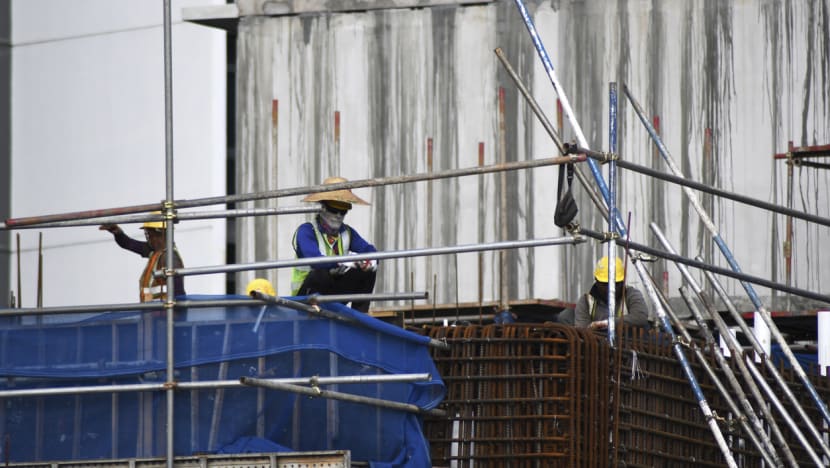Workplace injury, fatality rates fall in first half of 2025 as stricter safety measures pay off: MOM
There were 17 workplace fatalities in the first half of 2025, compared to 19 in the same period last year.

Workers at a construction site. (Photo: iStock)

This audio is generated by an AI tool.
SINGAPORE: Singapore’s workplace major injury rate dropped to an all-time low in the first half of 2025, excluding 2020 when work was disrupted due to the COVID-19 pandemic, the Ministry of Manpower (MOM) said on Tuesday (Sep 30).
In its latest workplace safety and health report, 286 workers sustained workplace major injuries from January to June this year. Major injuries refer to non-fatal injuries which are more severe in nature, and can include blindness, deafness, paralysis and amputation.
This translates to an annualised major injury rate of 15.5 per 100,000 workers in the first half of this year, maintaining the downward trend seen in recent years. The figure was 16.6 in the first half of 2024, and 17.4 for the same period the year before.
An annualised rate refers to an estimated rate should the six-month rate be sustained throughout the year.
The improvement is due to fewer incidents observed in the manufacturing and construction sectors, which are typically the main contributors to fatal and major injuries, MOM said.
The ministry recorded 17 workplace deaths in the first half of 2025, compared to 19 in the same period last year. This equates to an annualised rate of about 0.92 fatal injuries per 100,000 workers, or a decline from 1.0 in the same period last year.
Leading causes of fatalities included vehicular incidents, falls from heights and being struck by a moving object. Of the 17 deaths, seven were from the construction sector and four were from the transportation and storage sector.
The remaining four deaths were from the wholesale and retail trade, as well as the administrative and support services.
All 17 deaths were caused by Type A incidents, which are defined as incidents that carry a higher fatality risk. Examples include fire, crane-related incidents and the collapse of structures. Type B incidents are those that have a lower risk of causing death, such as exposure to hazardous substances, machinery incidents and physical assault.
Speaking to members of the media after a factory tour of window and door manufacturer Sapphire Windows on Tuesday, Minister of State for Manpower Dinesh Vasu Dash said that efforts have paid off.
"While it's always tragic to have any workplace fatality, we are trending in the right direction in terms of the number of fatalities," he said.
MOM has set a 2028 target of an annualised fatal injury rate of under one per 100,000 workers.
Still, Mr Dinesh said that the "best target" is zero.
"It's important for us not to be complacent, even though the data is in our favour ... So we must continue to remain vigilant and make sure that our workers are safe," he added.
On the reasons for the improved workplace safety outcomes, MOM attributed it to recent enforcement efforts that were implemented in recent years following spikes in safety incidents.
Efforts to improve workplace safety were intensified in 2022, following a series of workplace fatalities that year. A “heightened safety period” introduced mandatory safety timeout activities to review risks, along with targeted measures for the construction sector, such as a revised demerit point system.
In April 2024, MOM introduced stricter requirements for public sector projects, including adopting workplace safety technology and a bonus scheme incentivising strong safety performance.
After 10 fatal workplace incidents occurred between July and October 2024, the government-led Multi-Agency Workplace Safety and Health Taskforce also urged companies in the construction sector to take a safety timeout in November that year.
In the first half of 2025, MOM conducted over 3,000 workplace safety inspections across high-risk industries. Nearly 7,000 breaches were identified, with offending companies receiving more than S$1.5 million (US$1.2 million) in composition fines and 28 stop work orders.
The manufacturing sector recorded improvements in both fatal and major injury numbers, with overall rates falling by 15 per cent, or from 65 cases in the first half of 2024 to 55 cases in the first half of this year. There were no workplace fatal injuries in the sector from January to June.
MOM attributed the decline in cases to a demerit point system that was implemented since October 2023, and additional safety requirements introduced in January this year for certain machinery.
Despite improvements, the construction and manufacturing industries continued to contribute to a bulk of fatal and major injuries, or 43 per cent of cases.
Vehicular incidents, in particular, were the leading cause of workplace fatalities in the first half of this year.
Asked what more can be done to tackle such incidents, Mr Dinesh said that MOM is looking at additional ways to ensure worker safety not only while being transported, but also around vehicles at the work site.
MINOR INJURIES, DANGEROUS OCCURRENCES
MOM recorded 10,112 cases of minor injuries in the first half of the year. This was 3.2 per cent lower than the number of cases reported in the same period last year.
This translates to an annualised minor injury rate of 548 injuries per 100,000 workers. The figure represents a new low under the amended Work Injury Compensation Act, in which employers have to report all work injuries in any instance of medical leave or light duties. The amended act took effect in September 2020.
Slips, trips and falls, machinery incidents, and being struck by a moving object remained the top three leading causes of minor injuries, accounting for about half of the minor injuries recorded in the first half of the year.
In terms of industry, health and social services, manufacturing and the accommodation and food services sectors accounted for 48 per cent of minor injuries reported.
A total of 14 cases of dangerous occurrences - incidents with the potential to cause serious damage - were also reported to MOM in the first half of 2025. Nine cases involved fires and explosions, and five involved the collapse or failure of structures and equipment, MOM said.
REVISED OCCUPATIONAL DISEASE LIST
The number of occupational diseases reported in the first half of 2025 remained about the same, with 465 cases recorded compared to 468 cases in the same period last year.
Occupational diseases differ from workplace accidents as they are less visible. However, they can have a significant impact on workers’ quality of life, MOM said.
In the first half of 2025, the most common occupational diseases recorded included noise-induced deafness, work-related musculoskeletal disorders, and skin diseases.
MOM will also update its occupational disease list, which will come into effect from Dec 1. The revised list will expand the scope of work-related disorders under the Workplace Safety and Health Act and the Work Injury Compensation Act.
The revised list covers work-related musculoskeletal disorders beyond those affecting upper limbs and offers broader recognition of occupational infectious diseases.
Mr Dinesh said the expansion of the list is significant, as Singapore's workforce is ageing.
"These changes to the legislation ... will be an important step to ensuring that the senior workers are protected," he said.
















